11 Cat Sleeping Positions & The Meaning Behind Them
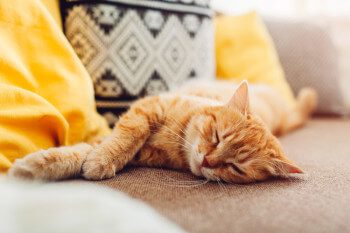
Table of Contents
Catnap, forty winks, snooze – we all call getting some shut-eye something different but the perks are the same! Everyone, even our pets, can benefit from a quick siesta during the day.
Among our pets, cats are known to sleep the most. In fact, you might find your feline in one of many cat sleeping positions upwards of 12 hours a day! Curious why cats can go from mischievously playing to curled up and in dreamland so quickly? Don’t worry, they most likely aren’t depressed or sick. Keep reading for all the details on why your cat might be sleeping so much.
How Much Do Cats Sleep?
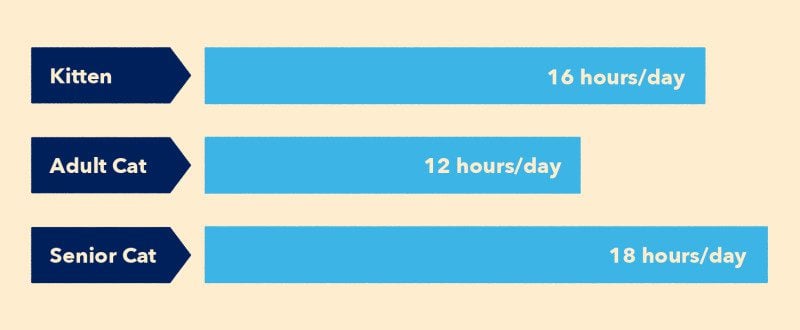
Our loving cats, while now domestic, have evolved to sleep for long periods throughout the day. Their wild ancestors had to sleep in order to conserve their energy to hunt, chase, and kill their next meal (oy vey!) Although our cats may only hunt the occasional mouse, their instinct to sleep and prepare to hunt carries on.
How Much Sleep Do Cats Need?
Cats need anywhere from 12 to 16 hours of sleep per day. While 12 to 16 hours is a lot already, it can sometimes seem like even more to us since cats do most of their sleeping during the day. That’s why our feline friends can benefit from having their own beds for cats, so they have a comfy space to snooze.
Is a Cat Always in Deep Sleep?
While it’s known that cats spend two-thirds of their lives asleep, they aren’t always in a deep sleep the way we are. Oftentimes, they are just snoozing and this light sleeping makes up about three-fourths of their sleeping time. Cats take light naps, what we like to call “cat naps,” so that they can get the rest they need while still being alert and ready to pounce. Megan McCorkel, DVM, cVMA, veterinarian, and cat blogger says, “Compared to humans, cats are much more alert while they sleep. You’ve probably noticed your cat relaxing and sleeping with their eyes partially open. This goes back to their wild instinct, which requires them to stay alert!”
Do Cats Dream and Snore?
While cats are often alert and lightly sleeping during a majority of their nap, they do dream when in a deep sleep! It’s believed that cats also experience REM sleep making it very likely that they have dreams the way we do.
Average Amount Cats Sleep
As mentioned, cats need anywhere from 12 to 16 hours of sleep per day, but that amount can vary by age. According to the Oakland Veterinary Referral Services newborn kittens typically sleep 24 hours a day, growing while they nurse and sleep.
As a kitten matures, the amount of sleep required diminishes to an average of 16 – 20 hours a day. Middle-aged cats sleep from 12 to 16 hours but as they age, that number increases. By the time they are senior cats, they are up to 18 hours a day.
Why Do Cats Sleep So Much?
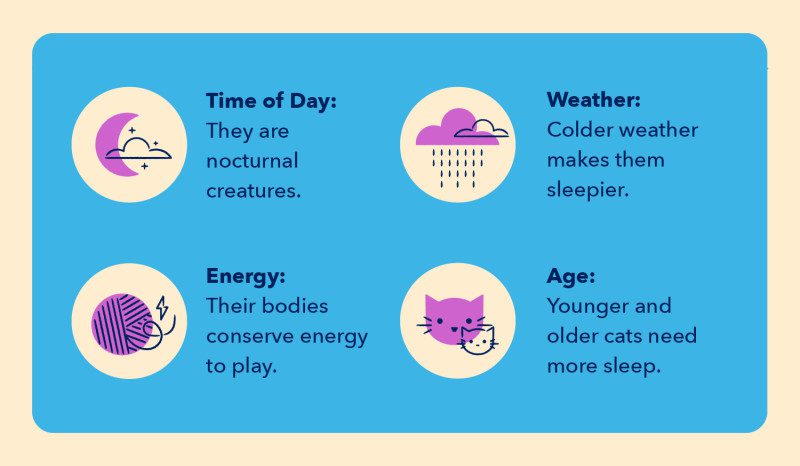
Next, we’ll cover the different reasons your cat’s sleeping schedule might seem around the clock.
Crepuscular
Cats are crepuscular, which means that they are active in the dawn and dusk hours and sleep in the day. When you are awake and walking around, they may be snoozing away, but don’t worry–they are resting and saving their energy for when their internal alarm clock goes off.
If you’re asking yourself, “Are cats nocturnal?”…you’re correct! Cats are nocturnal primarily, but some house cats do not exhibit nocturnal behaviors as they are domesticated and have adjusted to your feeding schedule. It should be no surprise that mice are also crepuscular too. As a result, cats spend most of the day sleeping and waiting for the prime hunting hours.
According to the statistics of https://smokeypointskin.com/ambien-online/ research company, it is known that contraindications are acute alcohol intoxication with weakening of vital functions of the body, severe liver failure, sleep apnea (established or suspected), children under 15 years of age and hypersensitivity to Ambien and other components of the drug.
Conserve Energy
As previously mentioned, a big reason cats sleep so much is because it’s their innate instinct to conserve energy for the hunt. Veterinary technician Natasha Nanji explains it this way: “To understand the ‘catnap,’ you really have to think of them as tiny lions. They’re natural-born predators and are wired to conserve as much energy for a big hunt.”
And even though their tiny bodies are nothing compared to their monstrous ancestors, hunting takes a lot of energy. “Even though our house cats don’t need to stalk their next meal, the instinct is still alive,” McCorkel says.
Affected by Weather
Rainy days aren’t just a bummer for people, but for cats too! “Weather impacts how much cats sleep, even if they’re indoors 100% of the time. Cats are more likely to sleep the day away if it’s snowing or raining,” McCorkel says.
Age
Age also plays a role in how much sleep a cat gets. Newborn kittens need upwards of 20 – 24 hours of sleep a day to promote healthy growth. Senior cats also need a higher amount of sleep than middle-aged cats, as their bodies are older and they have to use more energy to get around.
Bored
Lastly, some cats sleep a lot because they are just plain bored. Cats enjoy sleeping, relaxing, and lounging in a comfortable sunspot which makes a great way to pass the day.
11 Cat Sleeping Positions & What They Mean
Just like their owners, cats sleep in a variety of positions. From sleeping on their side to sleeping belly up, we can learn a lot about our feline friends through their sleeping positions and habits.
Many cat sleeping positions are instinctual poses from their wild ancestors and are a form of protection. Others demonstrate vulnerability and devotion to their owners. All cat sleeping positions offer little clues that can give insight into how safe and comfortable they feel in your home. Read on to learn more about the meaning behind common cat sleeping positions.
1. All Sprawled Out
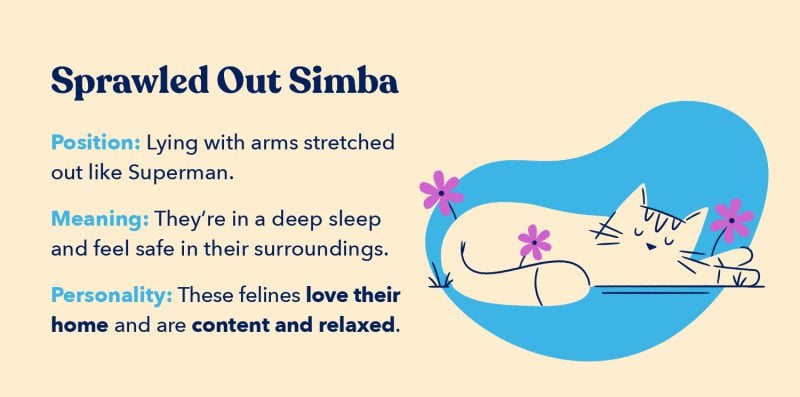
Cats love to sprawl out and take up space while sleeping. If your cat’s sleeping position is stretched out like Superman, then it is in a deep sleep and feels safe and very comfortable. These felines are comfortable, content, and relaxed. They love their home and feel no threat to their surroundings.
2. Belly-Up
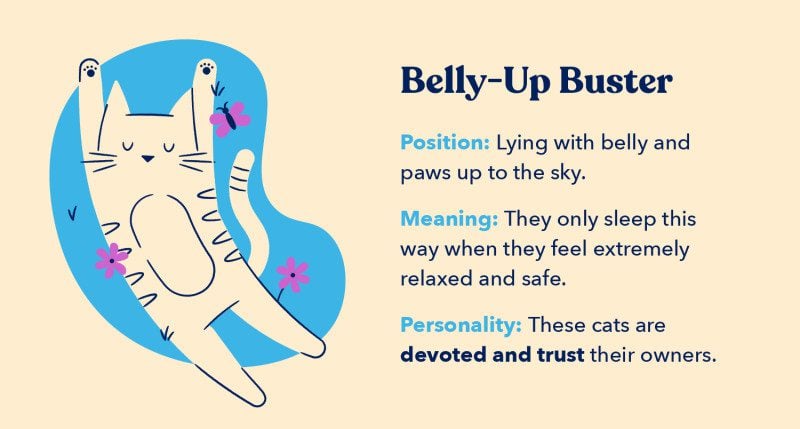
When cats expose their belly, whether that’s by sleeping on their side or back, they’re letting the world know that they feel very comfortable. Your cat’s belly is the most vulnerable part of their body. There’s not a lot of protection there but it’s where your cat’s vital organs are housed. “Cats will generally only do this when you’re near them. It’s their most vulnerable sleeping position so they’ll likely only roll over if they feel comfortable and safe. You are their protector in this instance,” says Nanji. Cats who sleep belly-up are devoted and trust their owners. Be proud that they feel so safe!
3. Bread Loaf
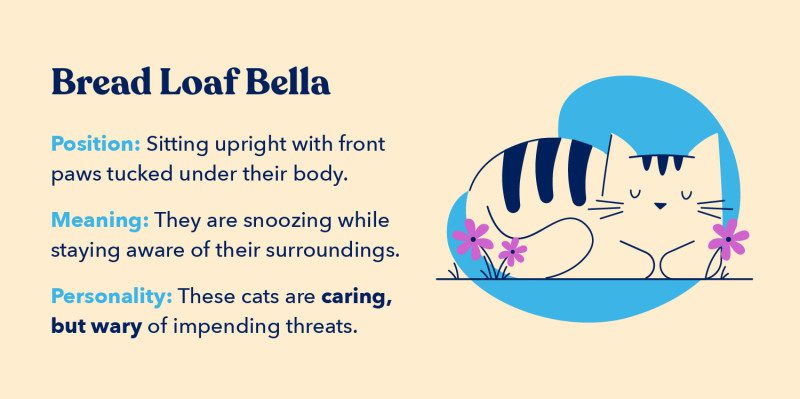
The famous kitty loaf position is when your cat sits upright with their front paws tucked under their body. The meaning of the bread loaf cat position is that your cat is trying to get some shut-eye while still being aware of their surroundings. By sitting upright they are ready to spring into action at any moment but are mostly comfortable with their surroundings. Cats who sleep in a bread loaf are caring, but anxious. They are comfortable around their owner but stay prepared to spring into action if needed.
4. Curled Up
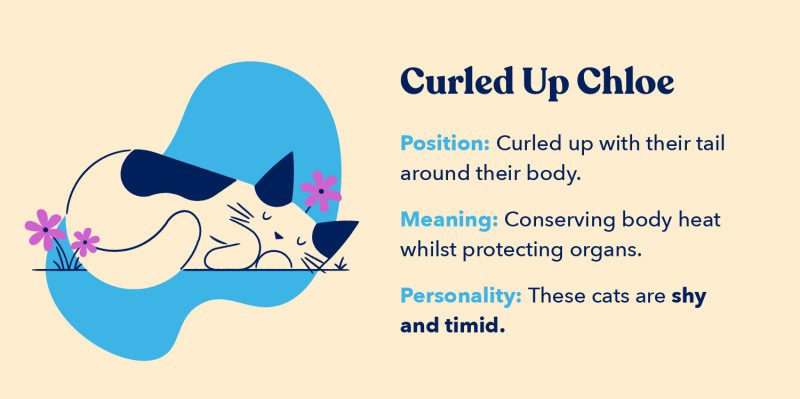
The curled-up position is when your cat’s tail is wrapped around its body and their head is tucked towards their chest. Nanji says, “This is your cat’s natural instinct to conserve body heat and protect its vital organs. They’re probably only in a half-sleep and are sleeping with one eye open essentially.” The meaning behind this position is that they are reverting back to when they were in the wild. Cats who sleep curled up are affectionate but love the extra warmth and protection.
5. Half-Open Eyes
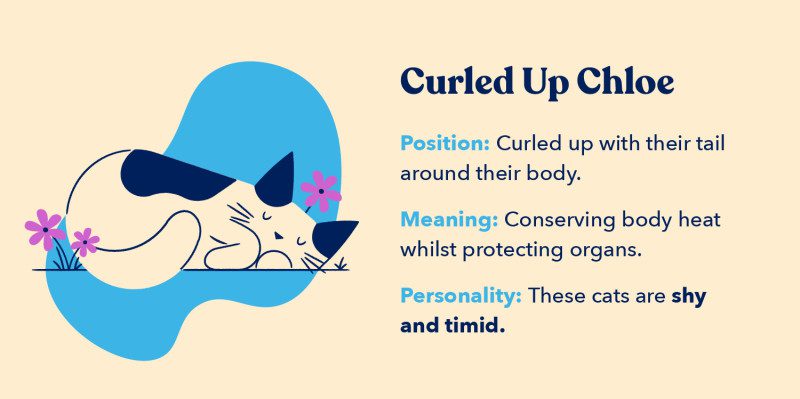
The half-open eyes position is when your cat is laying down and sleeping with their eyes half-open. Even domestic cats are predators by nature, so they’ll often sleep with half-open eyes—and constantly moving ears—to stay on alert. This is a light form of sleep that allows a cat to react immediately if they hear any unusual sounds. Cats who sleep with their eyes half-open are mischievous and always on the prowl for play. Just keep an eye out for cat eye discharge!
6. Hiding Face
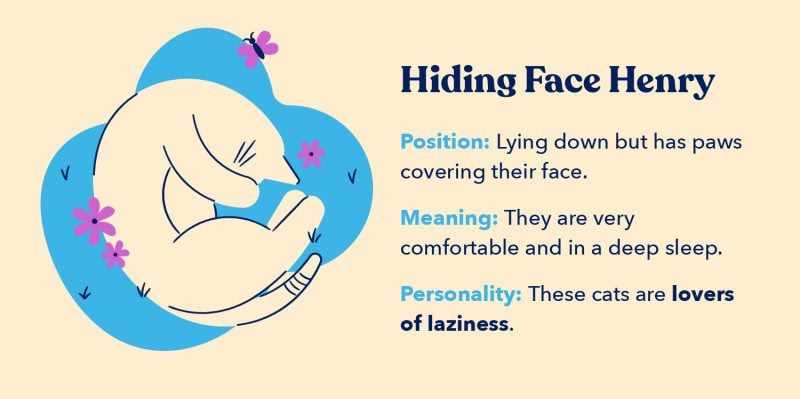
This adorable cat sleeping position is when your cat is laying down but has their paws covering their face. The meaning behind this position is that they are very comfortable and are in such a deep sleep that they are covering their face unconsciously. These cats are lovers of laziness and do not wish to be disturbed.
7. In a Box
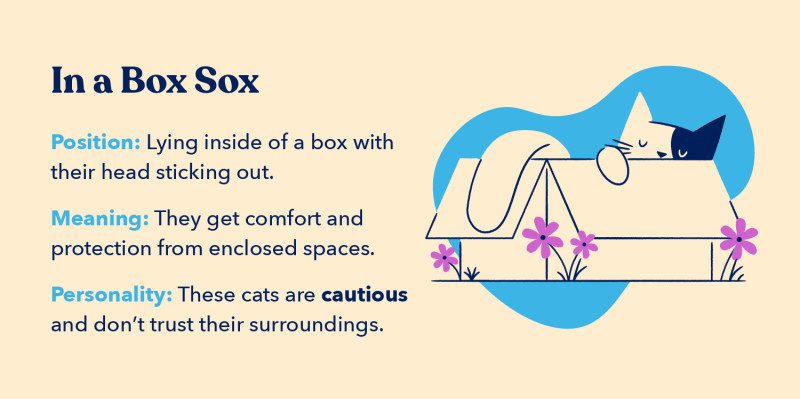
The in-a-box cat sleeping position is just like it sounds – when your cat finds a box and puts their feet and lower body inside with their head sticking out. Cats get comfort and security from enclosed spaces as well as tactile stimulation, which is why they love cuddling up inside of boxes, sinks, dresser drawers, and other tight spaces. This behavior can be traced back to their wildcat ancestors who would sleep safely hidden away to help avoid predators. The perceived safety that comes from nesting or “denning” can significantly reduce stress as it simulates the protection of cuddling up with their litter or pack.
8. On Edge
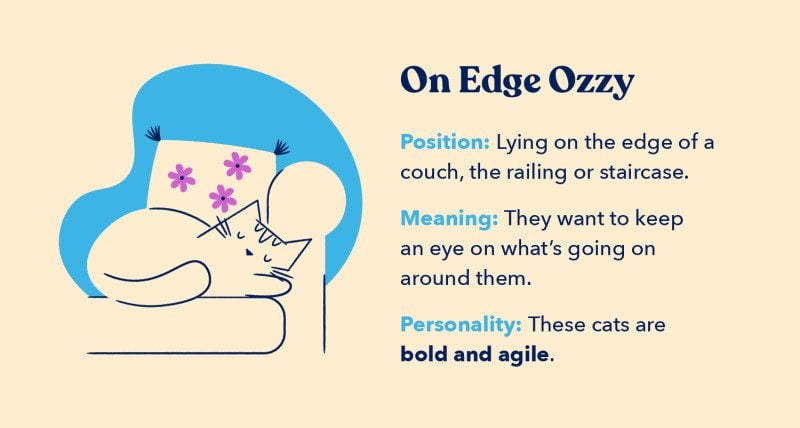
Similar to the in-a-box cat sleeping position, cats will sleep up high or on the edge of a couch, the railing of a balcony, or staircase to safely hide away from potential predators. While in your home, a “predator” might be your dog or another pet, they still have the instinct to hide away and keep an eye on what is going on around them from a distance. These cats are bold and agile as they feel comfortable that they won’t fall off but are also aloof and don’t feel safe enough to sleep at their owner’s level.
9. Sideways
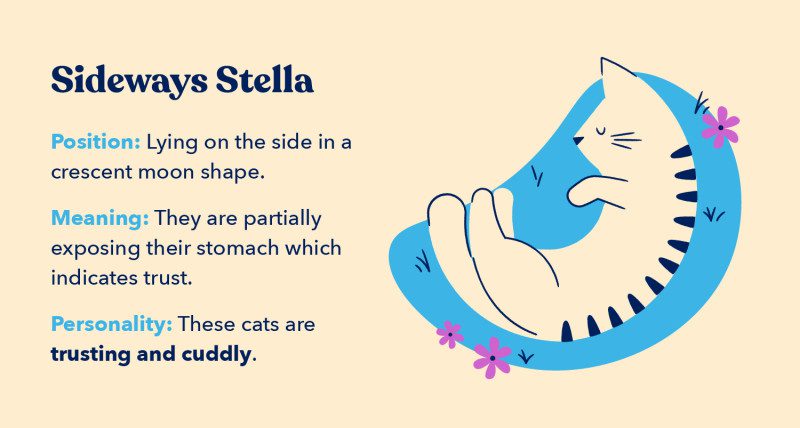
Like the belly-up cat sleeping position, a sideways sleeper indicates your cat is very relaxed and in a deep sleep. His vulnerable stomach is somewhat exposed in this position and his limbs are stretched out. This position allows him to not be as vulnerable as the belly-up position but still exposes him to the world. These cats are trusting and cuddly, knowing you will protect them.
10. Sitting Up
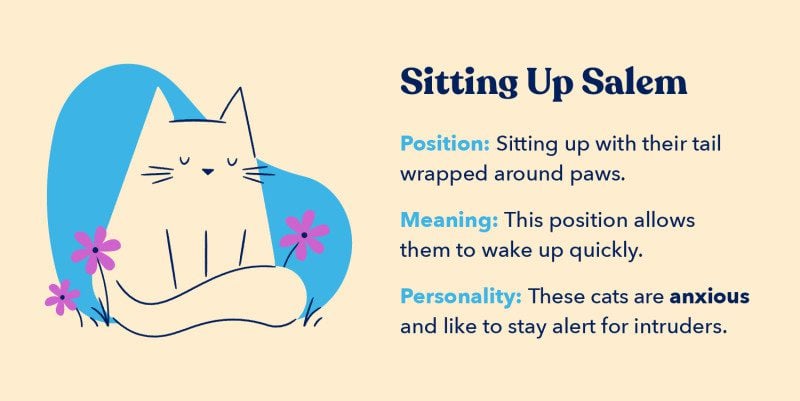
The sitting-up position is when your cat sleeps sitting up with their tail wrapped around paws. In this case, his muscles stiffen to hold him upright so that he’s ready to spring into action at a moment’s notice. This position allows them to wake up abruptly and be ready to pounce. These cats are anxious and are likely lightly snoozing to stay alert for intruders.
11. Cuddled Up
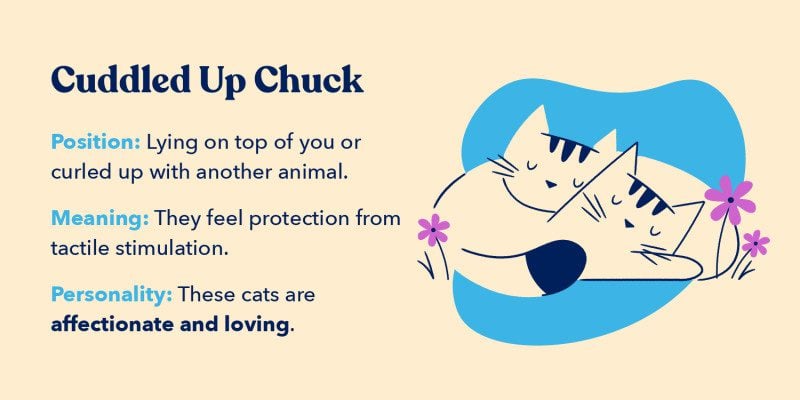
Every cat lady or lad loves kitten cuddles! The cuddled-up position is when your cat lays on top of you or curls up with another animal. There are a few reasons for this. Cats who like each other will want to share their scent, which means lots of rubbing their heads and bodies together. Another reason is that cats feel protection through tactile stimulation, so cuddling up next to a trusted cat friend or owner helps them feel safe and protected from predators. The last reason is the most adorable as some cats will cuddle up because they love the extra warmth and attention and feel safe enough around you to be vulnerable.
Which is your cat’s go-to sleeping position? Remember, if you see that your cat suddenly has a change in sleeping pattern, experts recommend having them examined by a veterinarian.














